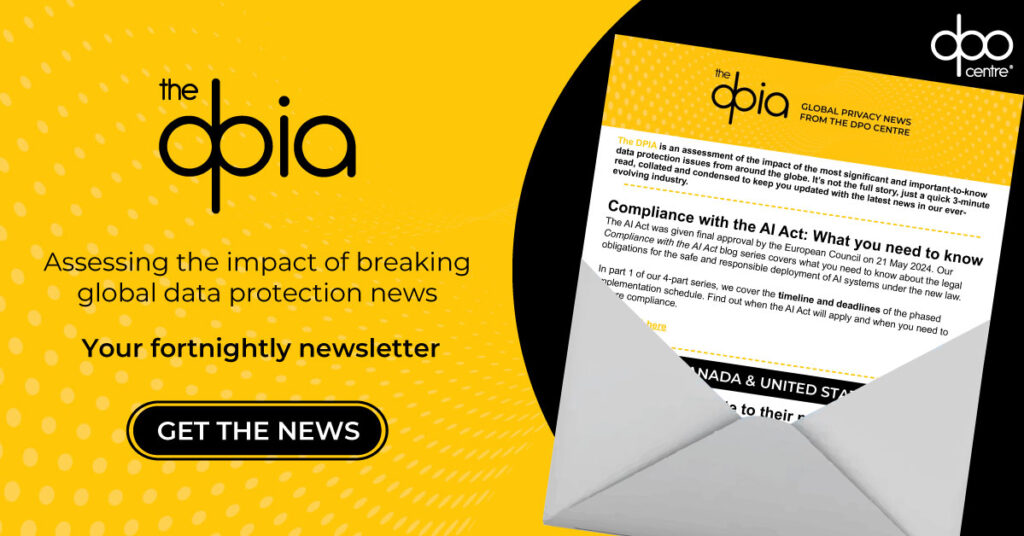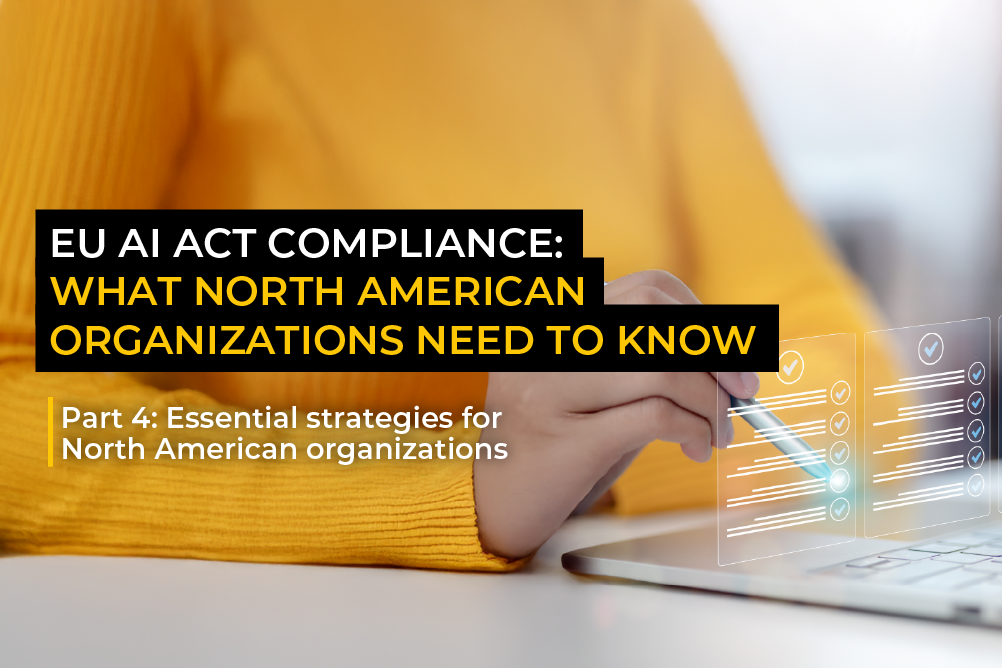As we wrap up our four-part EU AI Act blog series, this final installment explores some of the key strategies Canadian and US organizations can implement to keep ahead of the curve and ensure EU AI Act compliance.
For North American organizations, this often means implementing compliance measures that go beyond domestic requirements, particularly in areas like algorithmic transparency and bias testing.
If you’re developing or deploying AI systems for EU markets, your compliance journey is likely to be complex and demanding, especially if you’re managing high-risk systems. But compliance has to be approached as more than a tick-box exercise. It’s an opportunity to lead the way in responsible AI innovation, building trust with users and regulators alike.
By embracing compliance as a catalyst for more transparent AI usage, organizations can turn regulatory demands into a competitive advantage.
Before we dive into the specifics of the essential compliance strategies you should consider, here’s a quick overview of the main points we’ve previously addressed:
What we’ve covered so far
By following our blog series, you’ll already have taken the first steps in preparing for compliance with the EU AI Act. Specifically, you should have:
- Determined whether your AI system falls under the AI Act based on how it affects EU markets
- Identified any exemptions (e.g. research, military use)
- Clarified your role in the AI value chain (i.e. Provider, Deployer or another role)
- Understood the purpose of your system, and whether it’s classified as ‘prohibited’, ‘high-risk’ or a General Purpose AI model (GPAI)
The EU AI Act comes into full effect in August 2026
There are certain provisions coming into force earlier, such as a ban on systems that perform prohibited functions. It’s important organizations make sure they give themselves plenty of time and resources to meet all aspects of the AI Act’s implementation deadlines.
More detailed guidance on the timelines and deadlines, risk-based classifications, and compliance obligations, can be found in parts 1-3 of this blog series:
Compliance with the AI Act blog series
- Part 1: Essential knowledge for North American organizations
- Part 2: Understanding ‘high-risk’ activities
- Part 3: Roles and requirements for North American organizations
Let’s now look at some of the essential strategies you can implement to support your AI Act compliance journey.
Key strategies for EU AI Act compliance
1. Staff awareness and training
All organizations intending to use AI systems in any capacity should carefully consider the potential impact of those systems and engage in staff awareness and upskilling.
Training is essential to ensure all team members understand their roles in compliance and are able to implement the AI Act’s requirements.
A comprehensive training program should address the AI Act’s key requirements and include role-specific details. For example, AI developers may need more in-depth technical training, while Compliance Officers need to focus on documentation and regulatory obligations.
Tailor staff training programs to the specific risks associated with the type of data processed and the system’s intended use. For example, employees working with systems that have a greater impact on individuals, such as those making credit decisions affecting EU customers, may need more extensive training than those handling non-sensitive functions.
2. Establishing strong corporate governance
For Canadian and US organizations providing or deploying high-risk or General Purpose AI (GPAI) systems in EU markets, strong corporate governance is essential to demonstrate and maintain compliance. Without certain elements in place, organizations may struggle to meet the Act’s specific requirements and maintain the necessary compliance documentation.
To build and maintain strong corporate governance, organizations should focus on:
- Implementing effective risk and quality management systems to oversee and mitigate risks and help identify and address any issues early on
- Ensuring robust cybersecurity and data protection practices are in place to safeguard sensitive personal data and protect against data breaches
- Developing accountability structures with clear lines of responsibility to ensure compliance efforts are coordinated and effective
- Monitoring AI systems regularly and reporting on their performance and compliance status
Cybersecurity and data protection practices
To meet the stringent requirements of the AI Act, organizations should prioritize strong cybersecurity and data protection practices. This means embedding effective risk and quality management systems into your operations.
Without these practices, organizations may fail to meet specific requirements of the Act and will likely struggle to produce and maintain other compliance documentation that’s required.
For cybersecurity aspects, practices should include implementing robust infrastructure security with strict access controls, having a detailed incident response plan, and ensuring regular security audits to identify vulnerabilities.
The data protection requirements of the AI Act overlap with the EU’s General Data Protection Regulation (GDPR) in several areas and key principles, particularly around transparency and accountability.
While the GDPR focuses on the protection of personal data, the AI Act covers the broader development and regulation of AI systems. This includes not only safeguarding personal data but also managing overall AI risks to ensure fairness, prevent harm, and promote transparency.
You can use the GDPR principles and current data protection practices to support compliance with the AI Act by integrating ‘Privacy by Design’ into your AI systems, conducting Impact Assessments for high-risk AI applications, and maintaining clear documentation of data protection activities.
3. Being ready for upcoming guidelines and templates
Available in the coming months – the EU is developing specific codes of practice and templated documentation to help organizations meet their compliance obligations.
We’ll provide updates in further blogs as these become available.
4. Following ethical AI principles and practices
Although guidelines and practical applications of the EU AI Act are still evolving, its core principles are well established in ethical AI frameworks. Organizations using AI, especially with personal data or human impact, must understand how the system works, its purpose, and its limits. Documenting these aspects supports best practice and accountability.
Organizations must also comply with transparency requirements under existing data protection laws in addition to the specifics of the AI Act.
Finally, it’s essential to conduct a risk assessment of how the AI system may impact individuals who interact with it and the organization’s liability and reputation if anything should go wrong. This proactive approach to AI governance is highly beneficial and can mostly be implemented without needing to tailor it for specific regulations.
5. Seeking expert guidance
There are resources available to support your compliance journey. This includes the EU AI Act Compliance Checker , a tool designed to help organizations verify that their AI system aligns with regulatory requirements.
However, the nuances of the AI Act are complex, and we urge every organization uncertain of its obligations to seek professional advice.
Key takeaways
- To ensure compliance with the AI Act, organizations need to focus on critical areas such as staff training, robust corporate governance, and strong cybersecurity and data protection measures
- Embedding ethical AI principles and maintaining transparency are essential for Canadian and US companies developing AI systems that serve EU markets, especially those impacting individuals and handling personal data
- Although practical guidelines for the Act are still to come, businesses should proactively implement these strategies and prepare for future updates
In conclusion: Staying ahead of AI regulations isn’t just about compliance – it’s an opportunity to build trust and lead the way in responsible AI innovation.
The DPO Centre has developed a comprehensive AI Audit and Impact Assessment service. If you need support beginning or continuing your AI compliance journey with confidence, please contact us.
____________________________________________________________________________________________________________
In case you missed it…
- EU AI Act compliance part 3: Roles and requirements for North American organizations
- How GDPR territorial scope impacts North American businesses
- GDPR guide for SaaS companies expanding into EU & UK markets
____________________________________________________________________________________________________________
Don’t miss out on the latest data protection updates – stay informed with our fortnightly newsletter, The DPIA


